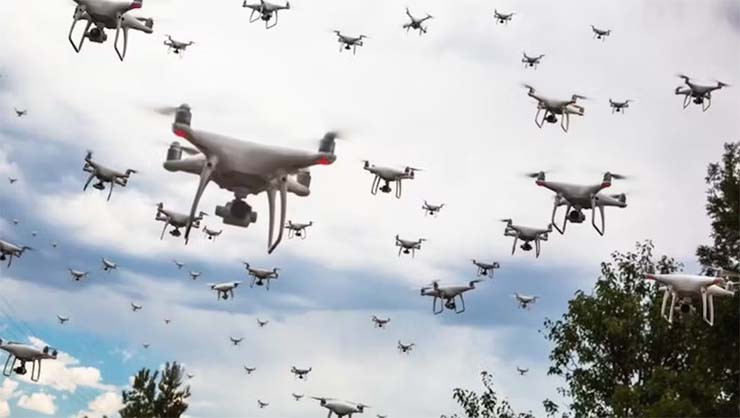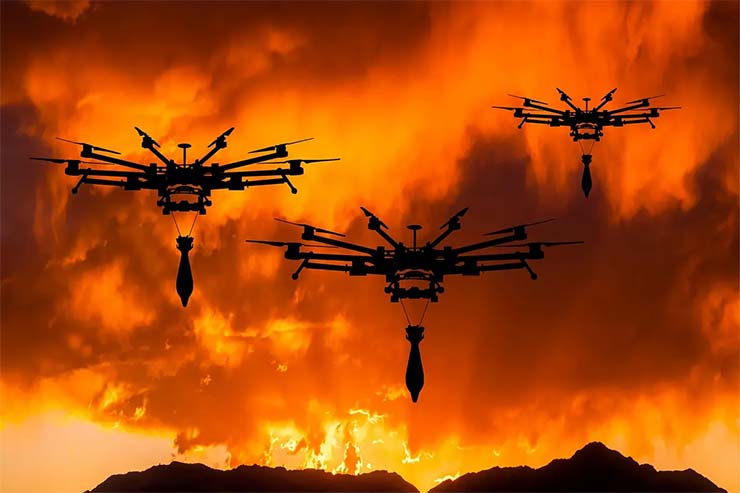
Russian capture of Avdiivka town in the Donbas region is in the news. Russian military released drone footage on February 18, 2024, showing a chaotic rout of Ukrainian forces, a day before actually receiving an order to do so from Kyiv’s freshly-appointed Army Chief, General Aleksandr Syrsky. The footage features large groups of soldiers trying to escape the town on foot and leaving behind heavy equipment to boost their chances of survival. Retreating troops were subjected to Russian artillery shelling that looked like air strikes, as seen in the footage. Multiple destroyed and damaged Ukrainian military vehicles can be seen in the videos released by the Russian Defence Ministry.
According to the New York Times, citing anonymous Ukrainian and Western sources, Russian Forces may have captured over 1,000 Ukrainian troops as they fled Avdiivka during their chaotic retreat, describing it as a devastating loss for Kyiv that could deal a blow to already weakening morale. Russia’s capture of Avdiivka is the biggest gain after Bakhmut in May 2023, which was followed by a Ukrainian counteroffensive. Some may consider this a largely symbolic win, but Ukraine will have to put in a herculean effort to avoid a catastrophe since the Russians are already opening another front in the north in Kharkiv Oblast.
It is not difficult to perceive that the two problems, besides other issues, that contributed to the Ukrainian rout in Avdiivka are: first, soldiers were thrown into battle with rudimentary weapon handling training and; second, there was a shortage of ammunition. In fact, these two problems afflict the Ukrainian military across the board. Ukraine President Volodymyr Zelensky said on February 19 that his troops were facing complicated fighting along sections of the sprawling frontline, with delays in Western military aid impacting his army.
A coalition of Ukraine’s allies has pledged to deliver one million drones to Kyiv within a year, while the United Kingdom and other nations plan to provide new AI-enabled UAVs that could swarm Russian targets simultaneously. Canada has announced it will send more than 800 drones to Ukraine starting as early as this spring
The fact is that the Ukrainian army is forced to expend ammunition at a much faster pace than what Western supplies can cope with. This is why the POTUS Joe Biden has been exhorting the military-industrial complex to speed up ammunition production. A similar appeal has been made by German Chancellor Olof Scholz who has had to hike the German defence budget to 2% of the GDP.
But the West is facing other problems, in addition to economies receding into recession. The bombings of Houthi have not made much difference. The Houthi are continuing their attacks against Western shipping and have recently released footage of shooting down an American MQ-9 Reaper drone off the coast of Yemen. Concurrently, concerns have become apparent in the US Navy about the shortage of Tomahawk cruise missiles, even as five American Carrier Battle Groups (CBGs) are headed towards the Western Pacific fearing Chinese invasion of Taiwan. Chinese President Xi Jinping had bluntly told Joe Biden at their summit in December 2023 in San Francisco that China will unify Taiwan with the mainland.

Another fear haunting the West is the possible Russian invasion of NATO countries. This was perhaps triggered by former US President Donald Trump saying he would ‘encourage’ Russia to attack NATO allies who do not pay their bills. Also, commenting on the ‘confrontation’ between America’s European allies in NATO and Russia, Trump recalled the military successes of the Russian Federation and said, “They defeated Hitler. They defeated Napoleon. This is a war machine.”
Trump’s remarks of encouraging Russia to attack NATO countries have invited much criticism but the Biden Administration is using the specter of Russia possibly attacking NATO countries to keep Europe tethered to Washington. Britain of course is the perpetually obedient pooch. NATO’s Joint Force Training Centre (JFTC) at Bydgoszcz in Poland has moved into a newly built, state-of-the-art facility with advanced Communication and Information System architecture. However, while the West is unable to cope with the ammunition requirements of Ukraine, what would happen if war erupts in other countries as well?
Britain’s Royal United Services Institute estimates that Ukraine is losing 10,000 drones every month but within a year will have more drones than soldiers, implying it will acquire over two million drones. To manage these capabilities, Ukraine recently established a new branch in its armed forces – ‘Unmanned Systems Forces’
The Wall Street Journal reported on February 3, 2024, that running low on ammunition amid stalled Western supplies, Ukraine has rationed munitions and plans to build a million explosive devices since it would take years before Kyiv could produce the kind of artillery and missile systems it needs on a large scale. A startup like Sparrow Aviva is producing 3,000 RPV drones every month, parts of which are made using 3D printers. Investment in drones by Ukraine stepped up following evidence of their success on the battlefield.
At the recent Munich Security Conference, officials warned it would become harder for NATO powers to establish control over airspace in conflict zones because of advances in drone technology; implying a greater need for European nations to bolster their air defence. A Ukrainian minister showed a video of the recent destruction of two Russian vessels near Crimea by underwater drones and said, “The drone fleet has opened Ukraine to the grain corridor in the Black Sea.”
Significantly, a coalition of Ukraine’s allies has pledged to deliver one million drones to Kyiv within a year, while the United Kingdom and other nations plan to provide new artificial intelligence-enabled UAVs that could swarm Russian targets simultaneously. Canada has announced it will send more than 800 drones to Ukraine starting as early as this spring. Google also announced $10 million in additional grants for Ukrainian startups during the conference.
A 3D-printed drone interceptor developed by startup Tytan Technologies to combat the cheap Iranian Shahed drones used by Russia was shown at the Munich Security Conference. The use of Artificial intelligence (AI) by rogue actors and AI’s dangers in cyberspace and social media was also discussed at the conference, for which technology companies announced countermeasures, including Alphabet’s Google presenting new tools for using AI to bolster online defences.
Swarm drones are already being used by both Russia and Ukraine. In fact, Russia at times has paired swarm drones with ballistic and cruise missile barrages. But with Ukraine being provided with over one million drones and the Western intention to hit deep inside Russian territory, the swarm drone war is set to intensify both overland and underwater.
A 3D-printed drone interceptor developed by startup Tytan Technologies to combat the cheap Iranian Shahed drones used by Russia was shown at the Munich Security Conference. The use of Artificial intelligence by rogue actors and AI’s dangers in cyberspace and social media was also discussed at the conference
Britain’s Royal United Services Institute (RUSI) estimates that Ukraine is losing 10,000 drones every month but within a year will have more drones than soldiers, implying it will acquire over two million drones. To manage these capabilities, Ukraine recently established a new branch in its armed forces – ‘Unmanned Systems Forces’.
However, the bottom line is that drones, including AI-enabled, have a big impact at the tactical level and less at the operational level, but at the strategic level, they remain more of a nuisance, as seen in the two-year-old war in Ukraine. At the operational and strategic levels, the integration of manpower and weapon systems and combined arms manoeuvres will continue to dictate the outcome of wars.
Finally, in a future war with China or China-Pakistan, which may not be short, especially in the case of China, India needs to be prepared for intensified swarm drone wars, even paired with ballistic and cruise missile barrages as Russia is doing in Ukraine. The requirement of low-cost lethal drones, as well as drone interceptors, 3-D printed or otherwise, must be catered for in advance with the provision of resupply during war. Equally important is the need to review the manpower to cope with the intensified swarm drone capability, as well as our ammunition holdings and re-supply during operations, for which it would be prudent to create indigenous capability.
-The author is an Indian Army veteran. Views expressed are personal. The views expressed are personal and do not necessarily reflect the views of Raksha Anirveda















